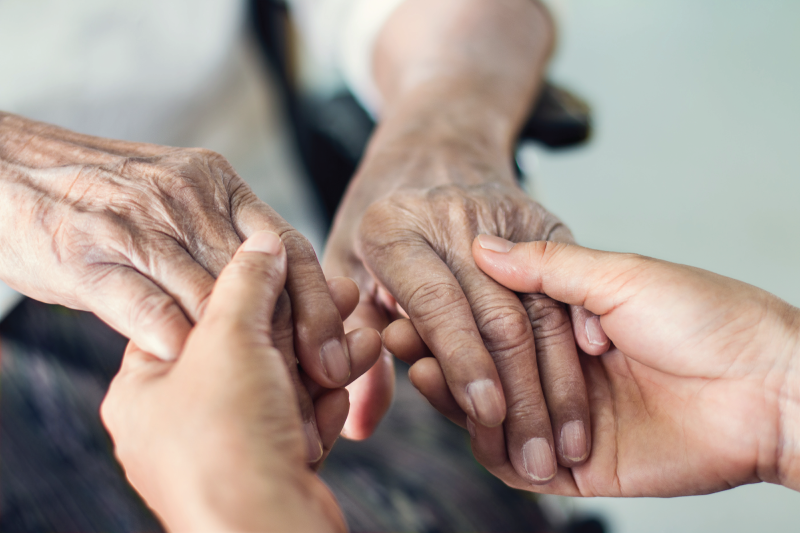Understanding peripheral neuropathy in cancer
Peripheral neuropathy is a nerve condition that can sometimes occur with cancer or its treatment.1,2
What is peripheral neuropathy?
Peripheral neuropathy is a condition that damages the nerves located outside of the brain and spinal cord (the peripheral nerves). These nerves carry information between the central nervous system – the brain and spinal cord - and the rest of the body, including muscles, skin, and internal organs. When they're damaged, communication can break down, leading to a range of symptoms.
Nerve cells are unique in that they are not easily replaced or repaired once damaged, unlike most other cells in the body.1,2
Peripheral neuropathy usually starts in the fingers or toes, and can progress up the legs and arms as it becomes more advanced.
Symptoms of peripheral neuropathy
Symptoms can include:1-3
- Mild: Tingling or ‘pins and needles’ in the hands and/or feet, cramping
- Severe: Numbness, loss of balance and control (due to reduced sensitivity), muscle weakness
- Other symptoms may include: constipation and ringing in the ears (tinnitus)
Symptoms may appear during or after treatment and can be temporary (weeks, months or years) or permanent. They may be worse at night and disrupt sleep, and can greatly affect quality-of-life – but there are often ways to help manage these, and your GenesisCare team will support you.
Peripheral neuropathy is usually caused by treatment, with chemotherapy being the most common cause.1-3
It is important to let your treatment team know of any symptoms you begin to experience as soon as they start. That way they can help you manage them.
The incidence of cancer-treatment related peripheral neuropathy is approximately ~38%, but is very dependent on the type, dose and duration of treatment.2,3
Why am I more likely to experience peripheral neuropathy with cancer?
There are a number of cancer-related causes of peripheral neuropathy including:1-3
- certain chemotherapy drugs
- immunotherapy drugs
- some other drug treatments such as antibody therapies
- combination of neurotoxic anti-cancer agents in your treatment regimen
- prior treatment with other neurotoxic drugs (e.g. chemotherapy)
- tumours pressing on nerves
- surgery or radiation that damages nerves
- some types of cancers are more likely to cause it than others such as lung, myeloma and lymphoma
Other risk factors include:
- pre-existing peripheral neuropathy
- alcoholism
- smoking
- diabetes mellitus
- vitamin B and/or other nutritional deficiencies
- advancing age (more common over 60)
- multiple myeloma and Waldenstrom's disease
- family history of hereditary neuropathies.
Can it be prevented?
Unfortunately, there are no preventative treatments for peripheral neuropathy in cancer, but there are ways to manage it – see below.1-3
If you start having symptoms during your treatment, tell your treatment team immediately. Your doctors adjust your treatment dose or increase the time between cycles to allow the nerves to recover and prevent permanent damage.1-3
If you have any previous nerve damage, get this assessed prior to treatment. Diabetes needs to be managed well, with blood sugar levels monitored carefully to lower your risk.1-3
Limiting the amount of alcohol you drink, maintaining a healthy weight and not smoking may all also help lower your risk.1-3
Make sure you speak with your treatment team about any medications you are taking to ensure none of them will increase your risk.

Will it get better?
Some cancer treatments cause short episodes of peripheral neuropathy during or just after treatment. These episodes tend to go away within a few days.1-3
For other types of treatments, the symptoms may last longer, starting during treatment, with the risk increasing as the number of treatment cycles progresses.
Sometimes, peripheral neuropathy can develop or worsen over time, even after your treatment has finished.1-3
In many cases, once treatment has finished, the symptoms will begin to improve over 6-12 months. However, in some people symptoms are permanent and may be mild or severe. Permanent effects are more common if you’ve had intensive treatment – high-dose chemotherapy – or if you have diabetes or other risk factors (see above).1-3
What can I do to manage my symptoms?
Depending on the severity of your pain/discomfort, your doctor may prescribe duloxetine (currently the only agent shown to help neuropathic pain in cancer-related peripheral neuropathy). There are other prescription medications which your doctor may use in an off-label fashion.2
Some people get relief from over-the-counter pain medications such as paracetamol and ibuprofen, and others find the topical application of lignocaine or capsaicin creams are effective.1,3
Other useful interventions that may assist with symptoms include:1
- exercise – gentle walks may lower the risk of nerve damage and may assist with pain management
- caring for your hands and feet – moisturising, keeping your nails trimmed, wear gloves when washing up or gardening, ensure shoes are comfortable and not rubbing, avoid pressure from bed sheets by keeping covers loose
- prevent falls – keep rooms well lit, remove clutter and loose rugs, wear shoes without thick rubber soles for more awareness of the ground, place rails on stairs and in the bathroom
- prevent dizziness – ensure you are eating and drinking regularly, move slowly, sit down when putting on your shoes, when you rise from laying down, sit for a while before standing.
Where to go for help and more information
A number of organisations have resources available on peripheral neuropathy including:
- Cancer Council ACT: actcancer.org
- Cancer Council NSW: cancercouncil.com.au
- Cancer Council NT: cancer.org.au/nt
- Cancer Council QLD: cancerqld.org.au
- Cancer Council SA: cancersa.org.au
- Cancer Council TAS: cancer.org.au/tas
- Cancer Council VIC: cancervic.org.au
- Cancer Council WA: cancerwa.asn.au
- Cancer Council Australia: cancer.org.au
- EviQ Australia, cancer treatment information: eviq.org.au (search peripheral neuropathy)
- Cancer Council. (2024). Understanding Peripheral Neuropathy and Cancer. Available at: www.cancer.org.au/assets/pdf/understanding-peripheral-neuropathy (accessed August 2025).
- Staff, N. P., Grisold, A., Grisold, W., & Windebank, A. J. (2017). Chemotherapy‐induced peripheral neuropathy: a current review. Annals of neurology, 81(6), 772-781.
- eviQ (Cancer Institute NSW). (2023). Anti-cancer drug induced peripheral neuropathy. Available at: https://www.eviq.org.au/clinical-resources/side-effect-and-toxicity-management/neurological-and-sensory/1743-anti-cancer-drug-induced-peripheral-neuropath (accessed August 2025)





